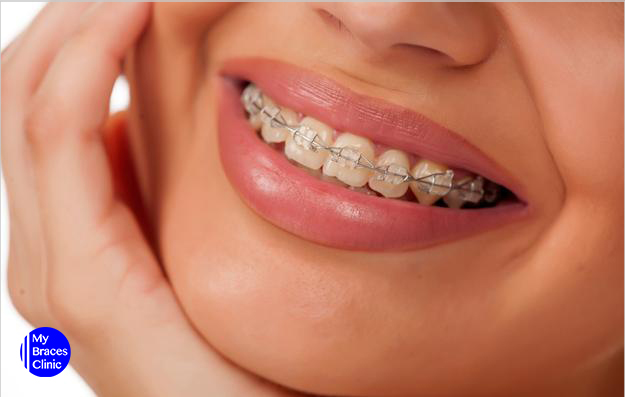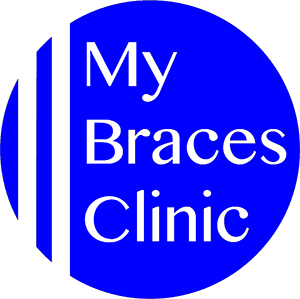
Dental braces have been the go-to solution for correcting misaligned teeth for decades. Today, advances in orthodontic technology allow patients to choose from a wider range of dental brace types. But with so many options, it’s easy to become overwhelmed when deciding what’s best for you. To help you make a more informed decision, we go over some common types of dental braces and their pros and cons.
1. Metal Braces

Metal dental braces are one of the most common types of braces used to correct misaligned teeth. The brackets, archwires, and elastic bands on the braces are made of high-grade stainless steel, and they work together to shift teeth into a desired position by applying gentle pressure on the teeth. Although metal braces are not as inconspicuous as some of the newer options available today, they remain a popular choice due to their effectiveness and affordability.
Pros:
- Durable: Metal dental braces are made from strong materials that can withstand the pressure of shifting teeth without breaking or bending.
- Customisable: Patients can customise the look of their metal braces by adding colourful elastic bands to the bracket.
- Very effective: Metal dental braces are highly effective at correcting severe misalignment and even complex orthodontic issues
Cons:
- Causes discomfort: Metal braces can cause soreness, irritation and ulcers, especially during the first few weeks of treatment.
- Dietary restrictions: Certain foods, such as hard candies and popcorn, have to be avoided as they can damage the braces or get stuck in the wires.
- Require frequent adjustments: Metal dental braces are designed to apply gradual pressure on the teeth to move them into the correct position. As the teeth begin to shift, the braces need to be adjusted and tightened again to ensure that pressure is constantly applied and the teeth can continue to move in the right direction.
2.Ceramic Braces

Ceramic braces work similarly to metal braces, but they are made of clear or tooth-coloured materials, which make them less noticeable. They also consist of brackets, wires, and elastic bands that help push the teeth into the desired position.
Pros:
- Aesthetic appeal: Because ceramic braces are less visible than metal braces, they are great for those who want to correct misaligned teeth without the obvious wires showing.
- Comfortable: Ceramic braces don’t cause much irritation or discomfort as the brackets are smooth and rounded. This reduces the risk of friction or abrasions on the cheeks and gums.
- Very effective: Ceramic braces are as effective as metal braces at correcting even severe cases of misalignment.
Cons:
- Costly: The materials used to make ceramic braces are more costly than the metal used in traditional braces. The manufacturing process for ceramic braces is also more complex and time-consuming, which drives up the cost of production.
- Prone to damage: Ceramic braces are made of ceramic or composite materials that are more brittle and prone to chipping or cracking.
- High maintenance: The elastic bands used with ceramic braces can discolour over time, requiring frequent replacements to maintain their appearance.
3. Self-Ligating Braces

Self-ligating dental braces are a type of orthodontic treatment that uses brackets with built-in clips instead of elastic bands to hold the archwire in place. These braces are designed to reduce friction and allow for more efficient movement of the teeth. They can be made of metal or clear materials, and are becoming an increasingly popular option.
Pros:
- Faster treatment time: Self-ligating braces are designed with a unique sliding mechanism that removes the need for elastic bands. This allows the archwire to move more freely, pushing teeth into the desired position quickly.
- Less friction and more comfort: The absence of elastic bands means that patients experience less pressure and soreness on the teeth and gums.
- Easy to maintain: With no elastic bands on the braces, patients don’t have to replace them and can enjoy fewer appointments. Self-ligating braces are also easier to clean than traditional braces as they have fewer parts and crevices.
- Less visible: Self-ligating braces can be made of clear materials, making them less visible than metal braces.
Cons:
- Costly: Advanced technology and specialised manufacturing processes are required to make self-ligating braces, increasing their cost of production.
- Not suitable for severe misalignment or bite issues: Self-ligating braces do not apply enough pressure to resolve severe misalignment issues. Metal braces are more suitable for more complex case.
4. Lingual Braces

Lingual dental braces straighten teeth using brackets and wires attached to the back rather than the front of the teeth. This makes them virtually invisible to others. Lingual braces are a popular choice for patients who want the benefits of braces but do not want them to be visible.
Pros:
- Aesthetic appeal: Because lingual braces are attached to the back of the teeth, they straighten teeth without unsightly wires in view.
- More precise fit: Lingual braces are customised to fit the unique contours of a patient’s teeth, which allows for a more precise and comfortable fit.
Cons:
- Difficult to clean and maintain: The position of the braces make it challenging to brush and floss them properly, which can lead to the buildup of food or plaque around the braces.
- Discomfort and soreness: The placement of the dental braces behind the teeth can cause discomfort and soreness on the tongue and inside the mouth.
- Costly: The customisation required to fit the unique contours of each patient’s teeth makes it costly to produce.
5. Clear Aligners

Clear aligners like Invisalign are popular alternatives to traditional braces. These aligners are made of clear plastic and are custom-fit to gradually move the teeth into their desired position.
Learn More: 5 Misconceptions of Invisalign
Pros:
- Discreet appearance: Because they are made of clear plastic, Invisalign braces are not visible and can be worn without anyone knowing.
- Removable: Unlike traditional braces, which are fixed to the teeth, clear aligners can be easily removed for meals and for brushing and flossing.
- Comfortable: Clear aligners are made of smooth plastic and do not contain any sharp brackets or wires that can cause discomfort or irritation.
Cons:
- Not suitable for more complex cases: Clear aligners work by applying gentle pressure to move teeth into their correct position. The trays used can only be worn for a specified amount of time before they need to be replaced with a new and tighter one. Severe misalignment may require more complex movements of the teeth, which may not be achievable with clear aligners alone.
- Costly: Clear aligners are customised to fit the unique shape of a patient’s teeth, which requires the use of advanced technology. This adds onto the cost of treatment. The clear trays are also made from high-quality, medical-grade plastic material.
The severity of misalignment, your personal preferences, and your budget all play a part in determining which dental brace will be best for you. To find the best type of braces for yourself, you should consult with an experienced orthodontist.
Considering straightening your teeth? The braces specialists at MyBracesClinic, a dental clinic in Singapore, can help you fix various teeth alignment issues to give you a confident smile. Find out more about our solutions here.




